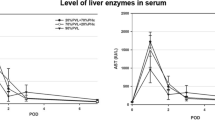Abstract
Background
Hypertrophy of non-clamped liver lobes and the atrophy of clamped lobes have been shown to be interactive. Here, a rat model of selective lobe occlusion was established to study the effect of contralateral ischemia/reperfusion (I/R) on regeneration of non-clamped lobes.
Methods
Left lateral and middle liver lobes were pretreated with I/R. In the experimental (IR + PVL) group, portal veins of the left and middle lobes were ligated. A group given similar portal vein ligation but no I/R (PVL) was the positive control.
Results
Compared with the PVL group, the IR + PVL had higher, but not remarkable, levels of serum transaminases; weights of non-clamped lobes in the IR + PVL group comparatively increased much more notably. At 24-h post-surgery, the IR + PVL group’s PCNA mRNA was up-regulated compared with the PVL group. At 72-h post-surgery, PCNA protein was up-regulated significantly, while TGF-β1 was down-regulated in the IR + PVL group notably, compared with the PVL group.
Conclusion
The I/R pretreatment given to the clamped lobes facilitates liver regeneration of non-clamped lobes after selective portal vein ligation, which may result from down-regulated TGF-β1 expression in non-clamped lobes.


Similar content being viewed by others
References
Lee KC, Kinoshita H, Hirohashi K, Kubo S, Iwasa R. Extension of surgical indications for hepatocellular carcinoma by portal vein embolization. World J Surg. 1993;17:109–115.
Seyama Y, Makuuchi M. Current surgical treatment for bile duct cancer. World J Gastroenterol. 2007;13:1505–1515.
Broering DC, Hillert C, Krupski G, et al. Portal vein embolization vs. portal vein ligation for induction of hypertrophy of the future liver remnant. J Gastrointest Surg. 2002;6:905–913. (discussion 913).
Adam R, Lucidi V, Bismuth H. Hepatic colorectal metastases: methods of improving resectability. Surg Clin North Am. 2004;84:659–671.
Tashiro S. Mechanism of liver regeneration after liver resection and portal vein embolization (ligation) is different? J Hepatobiliary Pancreat Surg. 2009;16:292–299.
Starzl TE, Demetris AJ, Van Thiel D. Liver transplantation. N Engl J Med. 1989;321:1014–1022.
Ploeg RJ, D’Alessandro AM, Knechtle SJ, et al. Risk factors for primary dysfunction after liver transplantation—a multivariate analysis. Transplantation. 1993;55:807–813.
Livak KJ, Schmittgen TD. Analysis of relative gene expression data using real-time quantitative PCR and the 2(-Delta Delta C(T)). Method Methods. 2001;25:402–408.
Assy N, Gong Y, Zhang M, Pettigrew NM, Pashniak D, Minuk GY. Use of proliferating cell nuclear antigen as a marker of liver regeneration after partial hepatectomy in rats. J Lab Clin Med. 1998;131:251–256.
Duval H, Mbatchi SF, Grandadam S, et al. Reperfusion stress induced during intermittent selective clamping accelerates rat liver regeneration through JNK pathway. J Hepatol. 2010;52:560–569.
Masuhara M, Yasunaga M, Tanigawa K, et al. Expression of hepatocyte growth factor, transforming growth factor alpha, and transforming growth factor beta 1 messenger RNA in various human liver diseases and correlation with hepatocyte proliferation. Hepatology. 1996;24:323–329.
Scotte M, Masson S, Lyoumi S, et al. Cytokine gene expression in liver following minor or major hepatectomy in rat. Cytokine. 1997;9:859–867.
Heinrich S, Jochum W, Graf R, Clavien PA. Portal vein ligation and partial hepatectomy differentially influence growth of intrahepatic metastasis and liver regeneration in mice. J Hepatol. 2006;45:35–42.
Kobayashi S, Nagino M, Yokoyama Y, Nimura Y, Sokabe M. Evaluation of hepatic interleukin-6 secretion following portal vein ligation using a minimal surgical stress model. J Surg Res. 2006;135:27–33.
Kanazawa H, Fujimoto Y, Teratani T, et al. Bone marrow-derived mesenchymal stem cells ameliorate hepatic ischemia reperfusion injury in a rat model. PLoS One. 2011;6:e19195.
Clarke C, Kuboki S, Sakai N, et al. CXC chemokine receptor-1 is expressed by hepatocytes and regulates liver recovery after hepatic ischemia/reperfusion injury. Hepatology. 2011;53:261–271.
Hsu MK, Qiao L, Ho V, et al. Ethanol reduces p38 kinase activation and cyclin D1 protein expression after partial hepatectomy in rats. J Hepatol. 2006;44:375–382.
Travali S, Ku DH, Rizzo MG, Ottavio L, Baserga R, Calabretta B. Structure of the human gene for the proliferating cell nuclear antigen. J Biol Chem. 1989;264:7466–7472.
Kuo WL, Yu MC, Lee JF, Tsai CN, Chen TC, Chen MF. Imatinib mesylate improves liver regeneration and attenuates liver fibrogenesis in CCL(4)-treated mice. J Gastrointest Surg. 2012;16:361–369.
Tanoue S, Uto H, Kumamoto R, et al. Liver regeneration after partial hepatectomy in rat is more impaired in a steatotic liver induced by dietary fructose compared to dietary fat. Biochem Biophys Res Commun. 2011;407:163–168.
Rehman H, Sun J, Shi Y, et al. NIM811 prevents mitochondrial dysfunction, attenuates liver injury, and stimulates liver regeneration after massive hepatectomy. Transplantation. 2011;91:406–412.
Revuelta-Cervantes J, Mayoral R, Miranda S, et al. Protein Tyrosine Phosphatase 1B (PTP1B) deficiency accelerates hepatic regeneration in mice. Am J Pathol. 2011;178:1591–1604.
Braun L, Mead JE, Panzica M, Mikumo R, Bell GI, Fausto N. Transforming growth factor beta mRNA increases during liver regeneration: a possible paracrine mechanism of growth regulation. Proc Natl Acad Sci USA. 1988;85:1539–1543.
Acknowledgments
This study was supported by a Research Fund for the Doctor of Harbin Medical University (no. BS 2007-15), Health Department of Heilongjiang Province (2010-075) and National Natural Science Foundation of China (No. 81170426).
Conflict of interest
None.
Author information
Authors and Affiliations
Corresponding authors
Rights and permissions
About this article
Cite this article
Yu, Jh., Zhang, Wg., Jiang, Gx. et al. Ischemia/Reperfusion in Clamped Lobes Facilitates Liver Regeneration of Non-clamped Lobes After Selective Portal Vein Ligation. Dig Dis Sci 57, 3178–3183 (2012). https://doi.org/10.1007/s10620-012-2298-x
Received:
Accepted:
Published:
Issue Date:
DOI: https://doi.org/10.1007/s10620-012-2298-x




